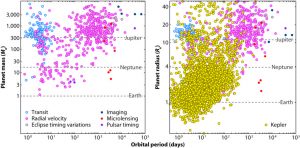Research
Introduction
Professor Seager’s main research goal is to find and identify another Earth, including the search for signs of life by way of biosignature gases. First things, first, and so we start with an introduction.

Thousands of planets are known to orbit nearby, sun-like stars. These planets are called “exoplanets”. Professor Seager’s favorite exoplanet diagram is the mass-period diagram shown to the right. This diagram shows that exoplanets have all masses and semi-major axes possible, showcasing the random nature of planet formation and migration. The different planet detection techniques are shown in the diagram. Parts of the diagram with no planets are where technology can not yet reach exoplanets. The figure below shows exoplanet discovery space as of 2014. Plotted as mass vs. orbital period (left) and not including Kepler discoveries. Plotted as radius vs. orbital period (right, and using a simplified mass-radius relationship to transform planet mass to radius) shows just how many exoplanets have been discovered, most by the Kepler Space Telescope. The paucity of planets of Earth’s size or mass and orbit emphasizes the challenge exoEarth discovery with any planet-discovery technique.
